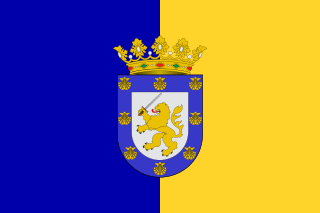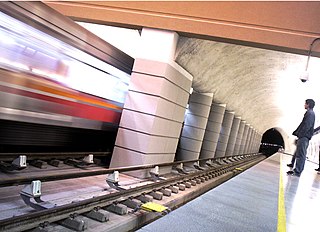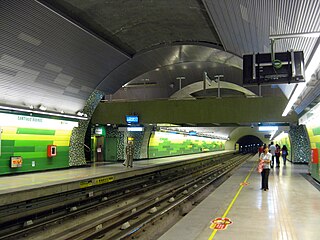
Santiago, also known as Santiago de Chile, is the capital and largest city of Chile as well as one of the largest cities in the Americas. It is the center of Chile's most densely populated region, the Santiago Metropolitan Region, whose total population is 8 million, of which more than 6 million live in the city's continuous urban area. The city is entirely in the country's central valley. Most of the city lies between 500–650 m (1,640–2,133 ft) above mean sea level.

The Santiago Metro is a rapid transit system serving the city of Santiago, the capital of Chile. It currently consists of seven lines, 136 stations, and 140 kilometres (87.0 mi) of revenue route. The system is managed by the state-owned Metro S.A. and is the first and only rapid transit system in the country.

Copilco is a station along Line 3 on the Mexico City Metro. Located in the Coyoacán borough, in the south of Mexico City, on Avenida Enríquez Ureña. It is the penultimate station along the southern portion of Line 3.

Miguel Ángel de Quevedo is a station along Line 3 of the Mexico City Metro. It is located in Mexico City's southern Coyoacán borough, at the junction of Avenida Miguel Ángel de Quevedo and Avenida Universidad.

Universidad de Chile station is a transfer station between the Line 1 and Line 3 of the Santiago Metro. It is an underground station located between La Moneda and Santa Lucía stations on the same line. It is located at the junction of Avenida Libertador General Bernardo O'Higgins, also known as "Alameda", and Paseo Ahumada in the commune of Santiago. The Line 1 station was opened on 31 March 1977 as part of the extension of the line from La Moneda to Salvador. The Line 3 station was opened on 22 January 2019 as part of the inaugural section of the line, from Los Libertadores to Fernando Castillo Velasco.

Universidad Católica is an underground metro station on the Line 1 of the Santiago Metro, in Santiago, Chile. It provides access to the Centro Cultural Gabriela Mistral and is named after the Pontifical Catholic University of Chile, whose main administrative offices are housed in a building close to the station. The station was opened on 31 March 1977 as part of the extension of the line from La Moneda to Salvador.

Puente Cal y Canto is a transfer station between the Line 2 and Line 3 of the Santiago Metro. Originally named Mapocho, it was renamed to Puente Cal y Canto shortly after its opening. This name is taken from the former bridge on the Mapocho River, whose remains were found during the construction of the station. The station's platforms walls have a decoration that resembles the architecture of the mentioned bridge. The Line 2 station was opened on 15 September 1987 as the northern terminus of the extension of the line from Los Héroes. On 8 September 2004 the line was extended to Cerro Blanco. The Line 3 station was opened on 22 January 2019 as part of the inaugural section of the line, from Los Libertadores to Fernando Castillo Velasco.

Américo Vespucio Avenue is a 64.8-kilometre (40.3 mi) ring road in Santiago, Chile named after Renaissance cartographer Amerigo Vespucci. Two adjacent sections of the avenue are occupied by Vespucio Norte Express and Vespucio Sur free-flow tolling highways, which are under concession. Vespucio Avenue meets the two largest roundabouts in Santiago, namely Quilín and Grecia, which have circumferences of 793 m and 535 m respectively.

Parque Bustamante is an underground metro station on the Line 5 of the Santiago Metro, in Santiago, Chile. It is located beneath Parque Bustamante, which gives the name to the station. The station was opened on 5 April 1997 as part of the inaugural section of the line, from Baquedano to Bellavista de La Florida.

Manquehue is an underground metro station on the Line 1 of the Santiago Metro, in Santiago, Chile. It is part of the 3.8 kilometres (2.4 mi) eastern extension of the Line 1. The station was opened on 7 January 2010 as part of the extension of the line from Escuela Militar to Los Dominicos,

República is an underground metro station on the Line 1 of the Santiago Metro, in Santiago, Chile. This station is named for República Avenue. The station was opened on 15 September 1975 as part of the inaugural section of the line between San Pablo and La Moneda.

Unión Latinoamericana, also known as ULA, is an underground metro station on the Line 1 of the Santiago Metro, in Santiago, Chile. It is close to Víctor Jara Stadium. The station was opened on 15 September 1975 as part of the inaugural section of the line between San Pablo and La Moneda.

Franklin is a transfer station between the Line 2 and Line 6 of the Santiago Metro. Their namesake is the Franklin Neighborhood. The Line 2 station was opened on 31 March 1978 as the southern terminus of the inaugural section of the line, from Los Héroes. On 21 December 1978, the line was extended to Lo Ovalle. The Line 6 station was opened on 2 November 2017 as part of the inaugural section of the line, between Cerrillos and Los Leones.

Los Orientales is an underground metro station on the Line 4 of the Santiago Metro, in Santiago, Chile. The station was opened on 30 November 2005 as part of the inaugural section of the line between Tobalaba and Grecia.

Del Sol is a metro station on the Line 5 of the Santiago Metro, in Santiago, Chile. The station is named for the nearby Autopista del Sol. The station was opened on 3 February 2011 as part of the extension of the line from Pudahuel to Plaza de Maipú.

Santiago Bueras is an underground metro station on the Line 5 of the Santiago Metro, in Santiago, Chile. It is named after Santiago Bueras, a soldier shot dead at the Battle of Maipú. The station was opened on 3 February 2011 as part of the extension of the line from Pudahuel to Plaza de Maipú.

Irarrázaval is a transfer station between the Line 3 and Line 5 of the Santiago Metro. The station is so named due to its location beneath Avenida Irarrázaval, a main road of the commune of Ñuñoa, which in turn was named after the Chilean lawyer and politician Manuel José Yrarrázaval Larraín. The Line 5 station was opened on 5 April 1997 as part of the inaugural section of the line, from Baquedano to Bellavista de La Florida. The Line 3 station was opened on 22 January 2019 as part of the inaugural section of the line, from Los Libertadores to Fernando Castillo Velasco. Construction of the 6.5 km tunnel between Irarrázaval and Fernando Castillo Velasco was completed in 2017 on a budget of 145 million euro.

Santiago Metro Line 1 is the oldest of the seven existing rapid transit lines that make up the Santiago Metro system. Being its busiest, it has a total of 27 stations along its 19.3 kilometre length, constructed almost entirely underground, and is located primarily along the axis formed by the Avenida Libertador General Bernardo O'Higgins, Providencia Avenue and Apoquindo Avenue.

Line 3 is a rapid transit line of the Santiago Metro. Traveling from La Reina in the east towards the center, and Quilicura in the North, Line 3 was originally intended to open in the late 1980s, but the 1985 Algarrobo Earthquake hampered its construction, and a subsequent urban explosion in Puente Alto and Maipú further put its construction on hold, until in the early 2010s construction started. The first phase of the project includes 18 stations, which were completed and opened to the public on 22 January 2019. The second phase, composed of a three-station extension towards the main square of Quilicura, should open by 2023. Its color on the map is chocolate.

Zapotitlán is a station of the Mexico City Metro in the town of Santiago Zapotitlán and in the colonia (neighborhood) of Conchita Zapotitlán, in Tláhuac, Mexico City. It is an elevated station with two side platforms, served by Line 12, between Nopalera and Tlaltenco stations. The station's pictogram features the glyph of Santiago Zapotitlán, which shows a toothed sapote tree with three branches. The station was opened on 30 October 2012, on the first day of service between Tláhuac and Mixcoac stations.





















